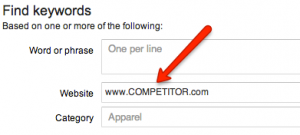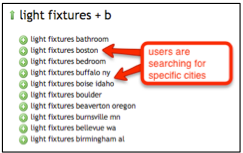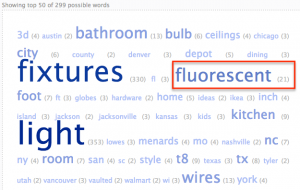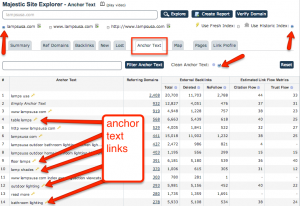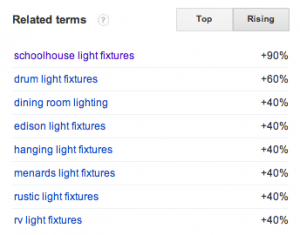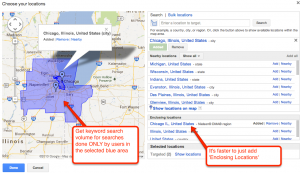Choosing Your Target Keywords
Keyword selection is the basis of any search marketing campaign. You need to know what you’re targeting before you can get to work trying to make your site more visible in search engines for the right audiences. With the rise of protected searches, (not provided), and the various updates Google makes to its algorithm targeting those that over-optimize, some may say that keywords are losing importance. As of today, this is flat out wrong. Until a searcher can enter more variables than a few words in a search input box, keywords will remain important. How you target them may change, but they will still be your primary targets for increasing your business through search.
To choose your target keywords you need to come up with keyword ideas first and then validate them based on search volume, relevance, and competition. First, we’ll go through various ways to come up with plenty of keyword ideas, using a few tools.
Keyword Idea Tip 1 – Google Keyword Tool
The easiest, and most well known for good reason, is to simply use Google AdWords. Enter a few keywords in and it’ll give you other keyword ideas along with search volume. You can take this a step further by entering your competitor’s URL in to see keywords they are using frequently.
Keyword Idea Tip 2 – Ubersuggest
Use Ubersuggest.org to find long tail keyword ideas. This tool shows all results from Google Suggest for a keyword + each letter of the alphabet. For example, if I have a site that sells light fixtures I can enter ‘light fixtures’ in to Ubersuggest and get results like the following screenshot shows.
On my own I may not have thought to target something like ‘light fixtures for vaulted ceilings.’ That’s a pretty specific topic that I could create a dedicated page or blog post for and possibly rank for.
Another great thing I can sometimes see with Ubersuggest is how frequent local searches are. For example, the following screenshot shows ‘light fixtures’ followed by city names, which tells me there may be opportunity to target specific locations that may have less competition than nationally.
One more way to use Ubersuggest is to select all of the keywords it suggests and paste them in to TagCrowd.com. This tool will show you the most frequent words used in a group of words, with more frequent words showing up larger in the tag cloud. For example, pasting the Ubersuggest results for ‘light fixtures’ in to TagCrowd produced this image.
Notice that I’ve highlighted ‘fluorescent’ as it’s not something I may have thought of right off the bat, but it’s showing up 21 times. Looking back at the Ubersuggest results for instances where the word ‘fluorescent’ was used I see phrases like ‘5 foot fluorescent light fixtures’ and ‘fluorescent light fixtures 48 inch’ as well as many other length variations. This gives us an idea to create a resource specifically geared towards the many length variations of fluorescent light fixtures, and that could rank for these various long tail keywords.
Keyword Idea Tip 3 – Competitor Meta Tags
Another way to get new ideas for keywords to target is to simply copy your competitors. You can look at their Title tags, H1 and H2 tags, Meta keywords (if they even use those). Looking at meta tags for all sites ranking for a keyword could take a lot of time as you’re probably thinking you need to open each site and look. Don’t waste your time, there’s a faster way using 2 FREE tools – Scrape Similar and Screaming Frog. In an effort to save time, I won’t go in to too much detail on how to use each tool, but feel free to ask in the comments. First, change your search settings by clicking the gear icon in the top right of Google and clicking Search Settings. Then drag the slider to 100, as so:
This will now show us 100 search results on ONE page of Google. Then, once the Scrape Similar plugin is installed on Google Chrome you just right click the top ranking link in a Google search result and select Scrape Similar from the menu and then export the data to Google Docs. You can then copy and paste all the URLs in to an Excel file and save it as a CSV. Now, open Screaming Frog and at the top of the screen click Mode and select List. This will allow you to upload a file for Screaming Frog to crawl. Where it says ‘select url list file’ you’ll click and find your CSV file of URLs. Then click start and the tool will crawl all 100 top ranking URLs for your keyword. Once it finishes crawling, export all the data as a new CSV.
Open the file and you’ll be able to see the Title tags, Meta Descriptions, H1s, H2s, Meta keywords, and more for each URL! Scan through the list and now you’ll know what keywords each of these sites are targeting. You can even take it a step further and find the most common words they’re collectively targeting by copying and pasting the data in to TagCrowd. I know this seems complex, but I swear that once you have the tools installed, it only takes 5 minutes.
Keyword Ideas Tip 4 – Competitor Anchor Text
This one is pretty simple. Enter your competitor’s domain in to a backlink tool such as MajesticSEO. Select the entire domain and historical index. Then click the Anchor Text tab and select ‘Clean Anchor Text’ to remove punctuation. This will show the anchor text links to your competitor’s site. If they’ve done any SEO in the past then they likely have some of their top keyword targets as anchor text. Google has been devaluing sites with an abundance of unnatural anchor text, but this can still identify what some of your competitor’s top money-makers have been in the past. Here’s a screenshot as an example.
Keyword Ideas Tip 5 – Google Trends
Another tool to keep in mind is Google Trends, which can give information on trending interest over time. In particular, it can tell you related keywords that are rising in interest. Here’s what we see when we search ‘light fixtures’ in the US over the past 12 months. I don’t know about you, but I never would have thought of ‘schoolhouse light fixtures’ or ‘drum light fixtures’ on my own, but it turns out they have decent search volume so maybe we add those to our list.
Those are just a few tips for coming up with keyword ideas. Once we have a long list we have to vet them to make sure we’re targeting the right ones.
Choosing Keywords – Relevance, Competition, & Search Volume
The best way will always be to simply search for each keyword and determine if the sites ranking for it make sense with your site. If half the sites aren’t relevant to what your site offers than it’s probably not the best keyword to target. Additionally, look at the types of sites ranking. Are they informational or are they selling products? For example, if you’re site sells a specific piece of medical equipment you might see sites like WebMD, Mayoclinic, Wikipedia, eHow, and government sites hogging the first page of results and if that’s the case you might want to try a longer, more specific keyword.
Competition is another thing to take in to account when choosing keywords. If your site is brand new then it’s probably unrealistic to think you’ll immediately compete for high volume keywords. Use tools like Moz’s Keyword Difficulty Analysis tool to quickly see the Moz metrics and link metrics for the top 10 sites ranking for a keyword. You can also use Moz’s SERP Overlay tool to see this data right in the search results.
Location Specific Search Volume
Of course, search volume also plays a big role in determining keywords to target. Obviously we want to target keywords with plenty of exact match search volume over keywords with very little. Just keep in mind those with higher search volume are likely more competitive. However, with how rapidly Google has been evolving, some search volumes can give false ideas of expected traffic potential. Many searches are now returning local results, as Google automatically detects your location. If your client is local, you might look foolish when their traffic numbers never live up to the search volumes your originally showed them despite having top rankings. Well, luckily we can now see location specific keyword search volume using Google’s Keyword Planner, but you will need to be signed in with your AdWords account. You can enter in keyword ideas and select your specific targeting location, as seen in the example screen shot below.
The area in blue is what you’ll get search volume data for. As you can imagine, the search volume just in Chicago is likely much different than in the entire US or another city. In my other post, you can follow a complete picture-guided step by step guide detailing how to use Google’s Keyword Planner.
Conclusion
Now you have 5 tips for coming up with keyword ideas and 3 factors to keep in mind to vet them. The final thing to keep in mind is ‘how much work do you want to put in?’ The more keywords you target, the more work you’ll likely have to do creating quality content and marketing it to the right audiences so don’t over do it.
If you have any comments or questions, please leave them below or send me a message on my Google+ and Twitter profiles.
Bonus Keyword Tools:
- MergeWords.com – Free, easy tool for instantly combining variations of keywords so you don’t have to type each one out.
- Soovle.com – Shows the keyword suggestions of multiple search engines.
- KeyWordDiscovery.com – Gives you even more keyword ideas.
Thanks for reading!
By Brian Donohue



